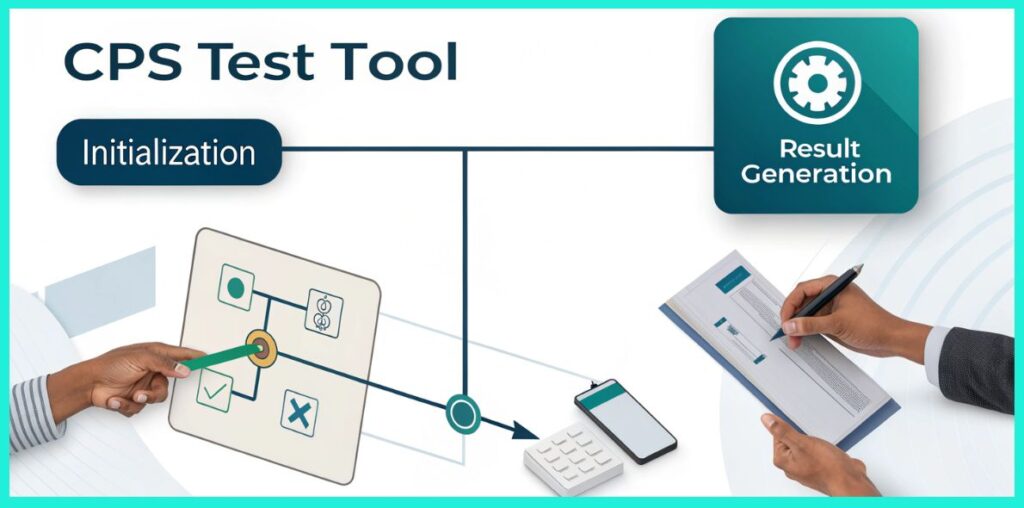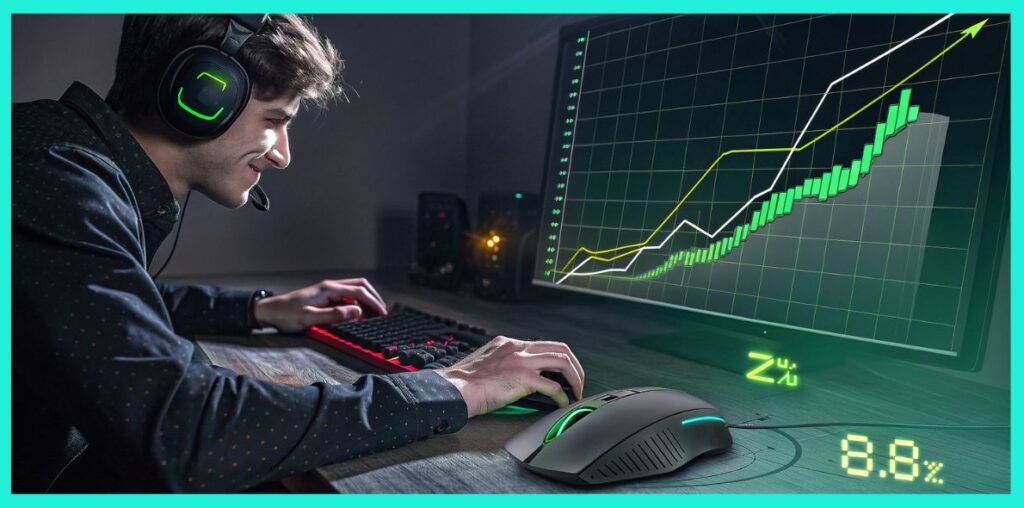CPS Test Tool
Test your clicking speed and compete with yourself
Click Speed Test
Click start to begin the test
Pro Tips
- • Use your index finger for consistent clicking
- • Keep your wrist stable and click with finger movement
- • Practice regularly to improve your speed
- • Try different time durations to find your peak performance
A Complete Guide To Click Speed And Performance
Clicking may seem like a simple everyday action, but in today’s digital environment, the speed and accuracy of clicks can influence everything from online gaming performance to productivity. The CPS Test tool, short for “Clicks Per Second Test,” has become a popular way to measure and improve clicking speed.
While it started as a fun challenge among gamers, it has evolved into a practical tool for testing reflexes, practicing hand-eye coordination, and even assessing the responsiveness of computer hardware.
This article provides a comprehensive, people-first guide to CPS testing, explaining how it works, why it matters, and how you can use it to enhance your skills.
What Is CPS And Why Does It Matter?
CPS stands for “Clicks Per Second,” a measure of how many times a person can click their mouse or tap their screen in one second. At first glance, this may appear trivial. However, reaction speed and accuracy are essential in many digital scenarios. For instance, in competitive games like Minecraft or Fortnite, faster clicking can mean landing an attack before your opponent. In workplace settings, quick and precise clicking ensures smooth navigation of complex software. Even outside of gaming and professional tasks, CPS tests provide a fun way to challenge yourself and compete with friends.
Clicks per second are usually measured over a defined time period. A short one-second test reveals raw speed, while longer intervals like 10 or 30 seconds give insight into endurance and consistency. Many CPS tools calculate not only the average clicks per second but also track improvement over multiple attempts, making it a valuable benchmark for progress.
Different Clicking Techniques
The way you click greatly influences CPS results. Regular clicking, which involves pressing the mouse button at a natural pace, produces an average of 5 to 7 clicks per second. More advanced techniques can significantly increase that number.
Jitter clicking involves tensing the arm and rapidly vibrating the hand to press the mouse button faster than normal. Although effective, it can cause strain if practiced for long sessions. Butterfly clicking uses two fingers alternating on the same button, doubling the speed and often reaching 15 to 25 CPS. A more extreme technique, drag clicking, takes advantage of friction between the mouse and finger to register dozens of clicks in a single movement, sometimes exceeding 40 CPS.
Table: Popular Clicking Methods and Average CPS
| Clicking Method | Typical CPS Range | Common Use Case |
| Regular Clicking | 5 – 7 | Everyday use, casual games |
| Jitter Clicking | 10 – 14 | Competitive gaming |
| Butterfly Clicking | 15 – 25 | Minecraft PvP, fast action |
| Drag Clicking | 25 – 50+ | Minecraft bridging, records |
Each method has its strengths and drawbacks. Drag clicking can achieve impressive numbers but is hardware dependent and not always allowed in gaming tournaments.
Regular clicking is safe for long-term use but limits competitive potential. Players often experiment with different methods to find the balance between speed and comfort.
How The CPS Test Tool Works

A CPS test begins with a timer. As soon as the test starts, every click is registered by the tool, which counts and divides the total by the duration to produce an average CPS score. For example, if you click 50 times in five seconds, your result is 10 CPS.
The beauty of online CPS tests lies in their simplicity. There is no need to install additional software; a browser-based tool is enough. The test area is usually a button or section on the screen where users click as fast as possible.
At the end of the timer, results are displayed instantly. Advanced versions of the tool also offer graphs showing speed changes during the test or allow players to save results to track long-term progress.
Offline tools and applications go a step further by analyzing hardware response rates. Developers often use these programs to stress-test new mice, ensuring that they register clicks accurately without delay. For casual users, however, online CPS tests are more than sufficient to measure performance and enjoy a quick challenge.
Why Use a CPS Test?
The reasons people turn to CPS tests vary widely. For gamers, it is often about performance. In fast-paced games, a few extra clicks per second can mean the difference between victory and defeat. In Minecraft PvP battles, for instance, a player with higher CPS can deliver rapid hits, block efficiently, and execute advanced maneuvers that slower opponents cannot match.
Professionals in other fields also find value in these tests. Graphic designers and coders often rely on high-performing hardware. A CPS test can reveal whether a mouse is responsive or if lag is interfering with workflow. Similarly, teachers and parents sometimes use these tools with children to improve coordination and reaction times in a playful environment.
And for many, CPS tests are simply entertaining. They are often shared among friends to spark light-hearted competition, with players comparing scores and attempting to break records. This mix of utility and fun has helped CPS testing spread far beyond the gaming community.
Improving Your CPS Score
Improvement comes from both technique and practice. Beginners should start with short tests of five or ten seconds, which allow them to focus on raw speed without tiring too quickly. Over time, longer tests help build endurance and consistency.
Hardware also plays a significant role. A high-quality gaming mouse with responsive switches will almost always outperform a standard office mouse. Grip style and posture matter too. Keeping the wrist relaxed, using the right grip (such as claw or fingertip grip), and positioning the mouse comfortably on the desk can prevent strain while allowing faster movements.
It is equally important to listen to your body. Methods like jitter and drag clicking can cause fatigue or even strain injuries if practiced excessively. Taking breaks, stretching fingers, and maintaining proper ergonomics will ensure that improving CPS remains safe and sustainable.
CPS In Gaming Performance

While CPS testing is enjoyable on its own, its influence is most visible in competitive gaming. In Minecraft, higher CPS translates directly into better combat mechanics. Players with faster clicking speeds can execute techniques like block-hitting or rapid bridging more effectively. In shooting games, although accuracy matters more than sheer speed, high CPS allows faster weapon switching and repeated actions.
That said, raw speed is not everything. A player who can click 20 times per second but lacks accuracy may perform worse than someone who clicks 10 times per second with perfect timing. Successful gamers balance speed with precision, practicing until fast clicking becomes natural without compromising control.
Common Misconceptions About CPS Tests
A common myth is that higher CPS always equals better gaming performance. In reality, many games have built-in limits that prevent clicks from registering beyond a certain speed. For instance, clicking 30 times per second in a game capped at 10 clicks per second will not provide any real advantage.
Another misconception is that any mouse can handle advanced techniques like drag clicking. In truth, only certain mice with specialized switches and textures are capable of sustaining such methods without wearing out quickly.
Lastly, CPS tests are not just for gamers. They are used in education, research, and software development, making them versatile tools for more than entertainment.
Coding Example: Simple CPS Test In Python
Below is a very simple code example showing how a CPS test can be created in Python. Instead of clicking with a mouse, the program uses the Enter key as the input.
This short script demonstrates the logic behind CPS tools. It records how many times the user presses a key within a five-second period and calculates the result. Web-based CPS tools use similar logic, though optimized for mouse events and touch inputs.
Fun Benchmarks: Average CPS By Age Group
Although there are no official global statistics, informal benchmarks show interesting differences in CPS among age groups. Younger players tend to have quicker reflexes, while older users may prioritize accuracy.
| Age Group | Average CPS | Notes |
| Children (6–12) | 4 – 6 | Developing coordination |
| Teens (13–19) | 6 – 10 | Gaming age group |
| Adults (20–40) | 5 – 8 | Balanced speed and accuracy |
| Seniors (40+) | 3 – 5 | Naturally slower reactions |
These numbers are not strict limits but reflect general trends. With practice, anyone can improve their CPS regardless of age.
Quick Tools
Refresh Rate Test
Measure your monitor’s refresh rate instantly and ensure smooth gaming performance online.
FPS Calculator
Calculate your frames per second using frame times to optimize gaming performance.
FPS Test Tool
Instantly measure your monitor’s frames per second and check gaming performance online.
🔹 Conclusion
The CPS Test tool is more than just an online game—it is a practical way to measure and improve clicking speed, reaction time, and hardware performance. Whether you are a gamer seeking competitive advantage, a developer testing input devices, or simply someone curious about your reflexes, CPS tests provide valuable insights.
By practicing regularly, experimenting with different techniques, and using reliable hardware, anyone can improve their score while maintaining comfort and safety. Ultimately, CPS testing is both a fun challenge and a useful tool, blending entertainment with practical benefits in the digital world.
FAQs About CPS Test
Q1. What is a CPS Test?
A CPS Test (Clicks Per Second Test) measures how many times a person can click their mouse within a specific time frame. It is often used as a fun challenge for gamers, speed testers, and people who want to improve their clicking speed.
Q2. How does the CPS Test work?
The test works by starting a timer when you begin clicking. Every mouse click is counted, and when the time ends, the total clicks are divided by the number of seconds. The result shows your CPS score.
Q3. Why do people take the CPS Test?
Many people use it for fun, but it’s also popular among gamers, especially in competitive games where fast clicking is useful. It can also be used to practice hand-eye coordination and reaction speed.
Q4. What is considered a good CPS score?
On average, 5–7 clicks per second is considered normal. Anything above 8 CPS shows faster than average clicking ability. Professional players sometimes reach 12–15 CPS or more using advanced techniques.
Q5. Are there techniques to improve CPS?
Yes. Some popular techniques include jitter clicking, butterfly clicking, and drag clicking. These methods help increase the number of clicks per second, though they require practice and sometimes special mouse hardware.
Q6. Is the CPS Test safe for your hands?
Taking the test casually is safe, but practicing extreme clicking techniques for long periods can cause strain or discomfort. It’s important to take breaks and avoid overdoing it to protect your fingers and wrists.
